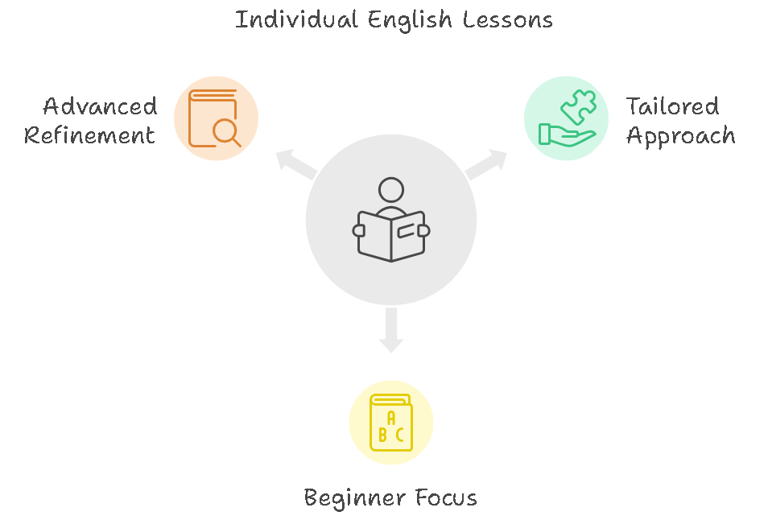Structure of the Lessons
Planning and structuring individual online English language training requires careful consideration to tailor the program to the learner’s specific needs, goals, and learning style. Here is a comprehensive guide to creating an effective training plan:
Step 1: Initial Assessment
Identify the learner’s objectives (e.g., improving conversational skills, preparing for an exam, professional communication).
Determine the learner’s current level of proficiency using standardized tests or informal assessments.
Understand the learner’s preferred learning methods (e.g., visual, auditory, kinesthetic).
Consider any specific interests or topics the learner is passionate about.
Step 2: Goal Setting
Set achievable short-term goals (e.g., mastering basic grammar, expanding vocabulary on specific topics).
Define long-term goals (e.g., achieving a specific CEFR level, passing the TOEFL/IELTS).
Establish milestones and a timeline for achieving these goals to track progress.
Step 3: Curriculum Design
Grammar and Syntax: Focus on foundational grammar rules and sentence structures.
Vocabulary: Develop vocabulary through thematic units relevant to the learner’s goals.
Reading and Writing: Incorporate texts and writing exercises appropriate to the learner’s level.
Listening and Speaking: Use audio and video materials to improve comprehension and spoken fluency.
Choose textbooks, online resources, apps, and multimedia materials suited to the learner’s level and interests.
Tailor materials and activities to address the learner’s specific weaknesses and strengths.
Step 4: Lesson Planning
Warm-Up (5-10 minutes): Start with a brief activity to review previous lessons or introduce the day’s topic.
Main Activity (30-40 minutes): Focus on the core content, whether it’s a grammar lesson, vocabulary building, reading comprehension, or a speaking exercise.
Practice (10-20 minutes): Provide opportunities for the learner to practice new skills through exercises or interactive activities.
Feedback and Review (10 minutes): Offer constructive feedback and review key points from the lesson
Use a mix of reading, writing, speaking, and listening activities to keep lessons engaging and cater to different learning styles.
Step 5: Regular Assessments and Feedback
Conduct regular quizzes, oral tests, and written assignments to monitor progress.
Implement more comprehensive evaluations at the end of each major unit or goal period.
Provide timely and constructive feedback on all assessments and during lessons.
Encourage self-assessment and reflection to help learners take ownership of their progress.
Step 6: Adaptation and Flexibility
Schedule periodic reviews to discuss progress, adjust goals, and modify the curriculum as needed.
Be prepared to adapt lesson plans based on the learner’s evolving needs and any challenges they face.
Step 7: Encouraging Autonomy
Encouraging independent learning. Assigning homework and self-study tasks to reinforce lesson content.
Encourage the use of English in daily life, such as reading books, watching movies, or conversing with native speakers.
Provide a list of recommended books, websites, podcasts, and other resources for further practice.
Example of a Lesson
Lesson Topic: Improving Conversational Skills
Objective: Enhance fluency and confidence in speaking about daily activities.
Warm-Up (10 minutes): Discuss the learner’s recent activities or a current event.
Main Activity (30 minutes): Introduce vocabulary related to daily routines. Practice using new vocabulary in sentences. Role-play a conversation about daily routines.
Practice (15 minutes): Engage in a dialogue practice where the learner describes their day while the instructor asks questions.
Feedback and Review (5 minutes): Provide feedback on pronunciation, grammar, and vocabulary use. Review key phrases and vocabulary from the lesson.
By following these steps an individualized online English language training program can be highly effective and rewarding.
Benefits of Individual Lessons


Personalized Learning Experience: Individual lessons allow for a customized curriculum that aligns with the learner's specific goals, interests, and pace. This ensures that each session is relevant and engaging.
Focused Attention: With one-on-one instruction, students receive undivided attention from the teacher. This enables immediate feedback and correction, which is crucial for language acquisition.
Flexible Scheduling: Individual lessons can be scheduled at times that are convenient for the student, making it easier to fit language learning into a busy lifestyle.
Targeted Skill Development: Students can focus on particular areas of the language they wish to improve, such as speaking, writing, listening, or reading comprehension.
Increased Confidence: Learning in a supportive environment allows students to practice speaking without the fear of judgment, helping to build their confidence in using the language.
